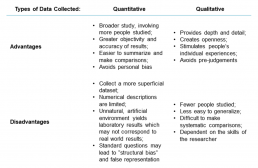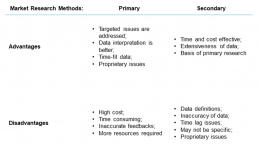Market research is the process of gathering, analyzing and interpreting information not only about the market and the product/service to be offered, but also about the past, present and potential customers for this product/service. The ultimate goal of any market research is to gain insights about the characteristics, spending habits, location and needs of your business’ target market and the potential competitors in your market and industry. Therefore, there are different types of market research.
The type of data collected can be categorized as qualitative or quantitative depending on the conclusion that it enables you to draw.
- Qualitative Research:
Explanatory research that helps you generally understand a topic and is often conducted through a small number of open-ended in-person interviews, which lead to your starting point hypothesis.
- Quantitative Research:
A much more structured approach that focuses on gathering specific data to improve or disprove the hypothesis created in the qualitative phase.
What is a hypothesis?
- A hypothesis is not a fact, and should not be argued as right or wrong until it is tested and proven one way or the other.
- A hypothesis is made on the basis of limited evidence and educated guesses resulting from data that you have gathered, any research you have done and the analysis of the current problems you have performed.
- A hypothesis is your starting point guess, before you plan how to test it, but based on the data collected with your results, you should be able to prove or disprove it.
As you may see in the figure below, each type of market research has valid advantages and disadvantages to consider. In the end, you should consider the one that fits you best.
Furthermore, the types of market research can also be distinguished as either primary or secondary depending on who gathered this data and in which context. Primary market research regards the information collected by talking, interacting and observing directly with customers and potential customers who will make the purchasing decision – i.e. the economic buyers. In contrast, secondary market research regards information obtained from market research reports and from indirect sources like the internet or analyst reports.
When to use which approach?
Essentially, primary market research is a type of market research conducted originally and exclusively by you in order to achieve a specific research objective for your business idea – i.e. a business that wants to know the viability of introducing a new product; while a secondary market research is a type of market research that regards a more generalized approach developed by a third party – i.e. a business that is planning to develop a mobile app and wants to know if it would be better to focus initially on an iOS or Android app. As you may see in the figure below, both types of market research approaches have advantages and disadvantages.
Primary market research can be very helpful when it comes to learning about your potential customers, and understanding what is the actual problem that they are trying to solve.
Excited to reach out to real customer and truly get to know them?
Simply sign up now to access our tutorials, videos and tools that guide you through the processes of brainstorming, narrowing, segmenting, selecting, sizing and describing your customer persona in order to ensure you are focusing on the best market.
All this, and a lot more – for free!









